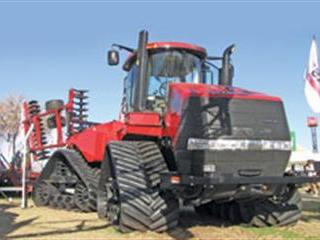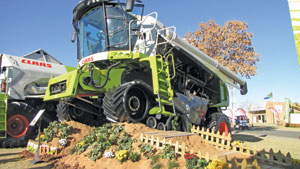
Comments by visitors to this year’s Nampo had a recurring theme: “Every year everything gets bigger and more expensive!” But appearances can be deceiving. Yes, the equipment on display is bigger, but is it really that much more expensive when you take into account work rates and overall efficiency?
The Lexion 750 combine harvester (Barloworld Claas stand) is a case in point. It costs R3,5 million, plus another R400 000 for the aluminium maize header, but the 770 version currently holds the world record for the most wheat harvested in eight hours.
At R2 000/t it would take only about 44 hours, working at this rate, to harvest enough wheat to pay off the Lexion’s price. Nampo marked the first showing of the Terra Trac option on a Lexion in South Africa. This enables the combine to operate in damp conditions and reduces compaction.

The Lexion 750 with Terra Trac system.
The header referred to comes from Allochis in Argentina. The 8-row aluminium model has a mass of only 1 720kg, about 1 000kg lighter than a similar size conventional steel unit. Also on display was the self-propelled Claas Jaguar 960 forage harvester. It sells for more than R4 million, but with 480kW of power available from the Mercedes engine the work rate is prodigious. Turning to tractors, the Case IH Steiger Quadtrac 600 costs about R4,5 million and the Baldan 12m Offset double disc harrow another R900 000.
That’s enough to make your eyes water. But when you consider that this rig, working highly efficiently, thanks to the GPS automatic steering system, at 12,3m wide and at about 12km/h, can cover almost 14ha/ hour, the cost becomes manageable. Factor in the ‘bright as day’ lighting system, making 24-hour shifts possible, and the investment starts to make real sense.








